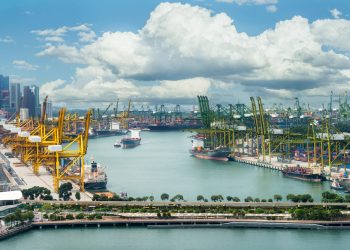The Port of Los Angeles has largely continued to preserve clean air gains that have reduced key pollutants, lowered health risk in surrounding communities and improved the quality of life in the greater Los Angeles area, according to data from the newly published 2015 Inventory of Air Emissions.
“Our clean air strategies were put to the test with the backlog of ships we experienced in the first part of 2015, and we largely held our ground,” said Port Executive Director Gene Seroka. “With this temporary situation behind us, we expect to see clean air progress when the numbers come in for 2016.”
Overall, diesel particulate matter (DPM) emissions remain down an unprecedented 85 percent from all sources related to port operations, replicating the Port’s record set in 2014. Likewise, sulfur oxides (SOx) emissions are down 97 percent, nearing total elimination. Nitrogen oxides (NOx) emissions are down 51 percent, just 1 percent shy of the 52 percent reduction rate in 2014.
The detailed inventory’s latest findings are based on data collected during calendar year 2015 and reviewed by regional, state and federal air regulatory agencies. The baseline is 2005, the year before the landmark San Pedro Bay Clean Air Action Plan (CAAP) was adopted. The results show the Port continues to exceed its 2023 targets for reducing DPM and SOx (77 percent and 93 percent respectively) and is within striking distance of its 2023 target of reducing NOx emissions 59 percent.
The Port also held the line on reducing the health risk of port-related emissions by lowering them 85 percent. That level sustains the progress achieved in 2014 when the Port hit its 2020 target.
In addition to criteria pollutants like NOx, SOx and DPM, the Port also tracks greenhouse gas (GHG) emissions, which contribute to global warming and are associated with climate change. The 2015 emissions inventory shows that GHG emissions were 10 percent below the 2005 baseline, but the 2015 GHG emissions were higher than Port GHG emissions in 2014, when they were 16 percent below the 2005 baseline. The increased 2015 GHG emissions are mostly attributable to congestion issues experienced in the first part of 2015. With congestion now behind it, the Port anticipates a return to larger GHG emissions reductions for 2016, as the Port continues in its efforts to achieve California’s goal of reducing GHGs 80 percent by 2050, based on 1990 levels.
In 2015, the Port moved nearly 8.2 million Twenty–Foot Equivalent Units (TEUs). Calculations that factor in fluctuations in container volumes reinforce the findings that the Port has held its ground.
Cargo handling equipment upgrades played a key role in offsetting congestion-related emissions in 2015, as the upgrades helped DPM emissions to remain stable compared to 2014 with only a small increase in NOx emissions. Replacing and retrofitting off-road terminal equipment has been a mainstay of the CAAP since its inception, and the use of Tier 4 equipment, referring to the cleanest available engines, jumped to 45 percent of all cargo handling equipment, up from 30 percent in 2014. Similar turnover is surfacing in the truck fleet with companies voluntarily upgrading to 2010 or newer engine models, exceeding CAAP requirements.
“The cargo handling equipment upgrades, particularly the ongoing transformation to new Tier 4 units reflect the ongoing commitment of our terminal operators, trucking partners, vessel operators and others have made to green our Port,” said Chris Cannon, Director of Environmental Management at the Port.
Ongoing vessel emissions reduction programs that helped protect clean air gains include the switch to cleaner vessel fuels, more ships running on electricity at berth, and operators voluntarily slowing ships in the harbor. Due to these and other vessel pollution reduction initiatives, ships calling at the Port now emit less DPM than locomotives and harbor craft combined.
Also significant is the industry trend toward bigger ships carrying more cargo to major ports. In 2015, 29 percent fewer vessels delivered 41 percent more cargo to the Port of Los Angeles, reducing the amount of fuel needed to move each container compared with 2005. Newer, larger vessels also have cleaner engines and more advanced technology that enhance their efficiency and shrink their emissions.
Going forward, reducing energy consumption will continue to play a critical role in the march toward zero emissions. That progress has already begun, and a pending CAAP update will incorporate strategies that advance energy efficiency solutions.
Examples include the conversion of TraPac to an automated marine container terminal and the Green Omni Terminal Demonstration Project. The latter is a full-scale, real-time demonstration of zero and near-zero emission technologies at the multipurpose terminal operated by Pasha Stevedoring and Terminals L.P.
The Port’s progress continues to be reflected in the reduced share of emissions its activity contributes to the South Coast Air Basin. The region is home to more than 16.8 million people in urban portions of Los Angeles, San Bernardino and Riverside counties and all of Orange County. Only 2 percent of all SOx emissions in the South Coast Air Basin are attributable to Port operations compared with 23.2 percent in 2005. DPM emissions from the Port account for 4.8 percent of the region’s total, about a third of what they measured in 2005. NOx emissions are 4.3 percent, down from 4.6 percent in 2005.
The Port of Los Angeles is America’s premier port and has a strong commitment to developing innovatively strategic and sustainable operations that benefit Southern California’s economy and quality of life. North America’s leading seaport by container volume and cargo value, the Port of Los Angeles facilitated $270 billion in trade during 2015. Port operations and commerce facilitate more than 133,000 jobs (about one in 14) in the City of Los Angeles and 479,000 jobs (or one in 18) in the five-county Southern California region. The San Pedro Bay Ports support nearly 1 million California jobs and 2.8 million nationwide.
You may view Port’s Inventory of Air Emissions Report Card by clicking below
Source: Port of Los Angeles



























































